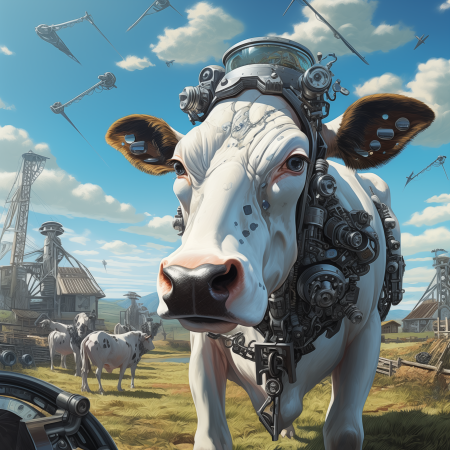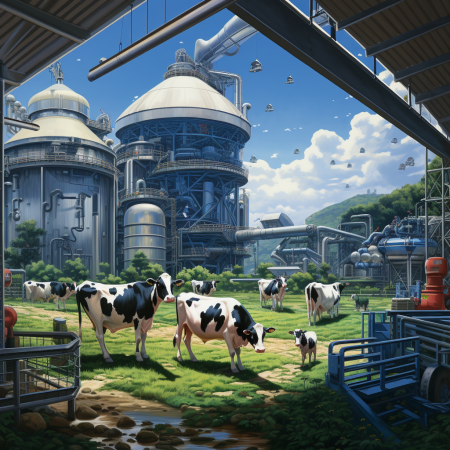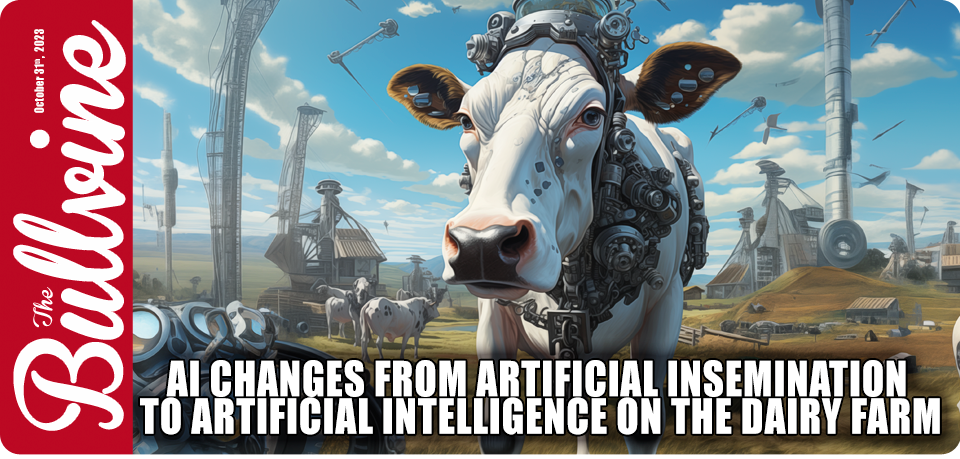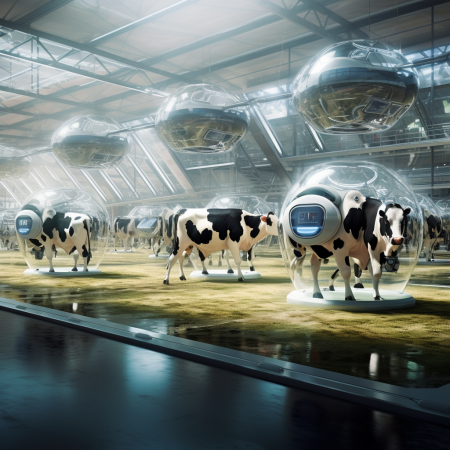Dairy farming has come a long way since its humble beginnings, with technological advancements continually shaping the industry. One such innovation that holds immense promise is the integration of artificial intelligence (AI) into dairy farming operations. AI has the potential to revolutionize the dairy sector by improving efficiency, cow health, and overall productivity. This article explores the various applications of AI on the dairy farm and the benefits it brings to both farmers and consumers.
 Precision Livestock Management
Precision Livestock Management
AI plays a crucial role in precision livestock management by monitoring and analyzing the health and behavior of dairy cows. Wearable sensors, such as collars or ear tags, equipped with AI algorithms can collect real-time data on a cow’s activity, temperature, and even eating habits. By analyzing this data, farmers can quickly identify signs of illness, estrus, or other issues, allowing for timely intervention.
- Data-Driven Decision Making
AI in PLM begins with data collection from various sensors and devices that monitor the health, behavior, and environment of livestock. These devices, including wearable sensors and IoT technology, gather data on parameters like body temperature, activity levels, and feeding patterns. AI algorithms analyze this data to provide farmers with actionable insights, enabling them to make informed decisions about animal welfare, resource management, and breeding practices.
- Early Disease Detection
One of the most critical aspects of PLM is early disease detection. AI plays a crucial role in this regard by continuously monitoring animal health indicators. By identifying subtle changes in behavior, vital signs, or feeding habits, AI can alert farmers to potential health issues before they become serious. This early intervention not only improves animal welfare but also prevents the spread of diseases throughout the herd.
- Individualized Care
AI-driven PLM allows farmers to provide personalized care to each animal in their herd. By analyzing data from sensors, AI can help create unique health and feeding profiles for each animal. This personalized approach optimizes nutrition, medication, and treatment, ensuring that each animal’s specific needs are met. It results in healthier, more productive livestock and minimizes resource wastage.
- Estrus Detection and Reproductive Management
AI can monitor the estrus cycles of animals and predict the optimal time for artificial insemination or natural breeding. By analyzing behavioral patterns and physiological data, AI improves reproductive efficiency. This leads to higher conception rates, reduced time and resources spent on breeding, and a more synchronized and productive herd.
- Environmental Monitoring
PLM isn’t just about animal health; it also encompasses the environment in which the livestock live. AI can analyze environmental data, including temperature, humidity, and air quality, to ensure that conditions are ideal for animal comfort and productivity. This data-driven approach minimizes stress on animals and helps to reduce environmental impacts.
- Resource Optimization
AI can assist in optimizing resource allocation on the farm. By analyzing data related to feed intake, water usage, and waste management, farmers can make more efficient use of resources. This reduces costs and minimizes environmental impact, making livestock operations more sustainable.
- Remote Monitoring and Alerts
One of the great advantages of AI in PLM is remote monitoring and real-time alerts. Farmers can keep a watchful eye on their livestock from anywhere, receiving instant notifications if an issue arises. This level of control and awareness is invaluable in preventing problems and ensuring the well-being of the animals.
Artificial Intelligence is ushering in a new era of Precision Livestock Management. By harnessing the power of AI to collect and analyze data from sensors and devices, farmers can optimize every aspect of animal care, from health and reproduction to resource management and environmental sustainability. The result is not only more efficient and profitable livestock operations but also improved animal welfare and a sustainable approach to agriculture that benefits both the farming industry and society as a whole. The future of PLM is undoubtedly intertwined with the capabilities of AI, promising further advancements in the years to come.
Automated Milking Systems
Automated milking systems (AMS) are becoming more prevalent on dairy farms, and AI is at the heart of these systems. AI-driven robots can identify each cow using optical recognition systems, locate the udder, and attach milking equipment. These systems also record data about milk quality and quantity, enabling farmers to make informed decisions about feeding, breeding, and healthcare.
This article explores how AI is enhancing the capabilities of automated milking systems and the impact on dairy farming.
- Identification and Data Collection
The integration of AI in AMS begins with precise identification and data collection. Each cow is equipped with a unique RFID tag or other identification method. AI-powered cameras and sensors recognize individual cows, allowing the system to tailor the milking process to their specific needs. This identification is not limited to merely distinguishing cows but can also record vital data about their health, milk production, and behavior.
- Automated Milking Process
One of the central functions of AMS is the automated milking process. AI plays a pivotal role in ensuring the milking procedure is efficient and gentle. The AI system locates the udder, attaches milking equipment, and monitors the milking process in real time. This not only minimizes stress on the cows but also maximizes milk yield and quality.
- Data Analysis for Individualized Care
AI in AMS goes beyond milking and data collection; it also provides valuable insights for individualized care. The AI system continuously collects and analyzes data on each cow’s milk production, temperature, activity, and other health indicators. By identifying anomalies or deviations, the AI can alert farm managers to potential health issues, ensuring prompt intervention and improved animal welfare.
- Milk Quality Assurance
Maintaining milk quality is of utmost importance in dairy farming. AI is employed to monitor the quality of milk during the milking process. If any irregularities are detected, such as signs of mastitis or contamination, the system can divert the milk from the main collection, preventing any subpar milk from entering the bulk tank.
- Optimization of Milking Schedules
AI can optimize milking schedules based on individual cow preferences and requirements. Cows often have their preferred times for milking, and the AI system can adjust milking times accordingly. This not only reduces stress on the animals but also maximizes milk production.
- Long-Term Performance Analysis
AI continuously collects data on the performance of the AMS and the cows. This data is valuable for long-term analysis, enabling farmers to identify trends and make informed decisions about equipment maintenance, upgrades, and the overall well-being of their herd.
- Remote Monitoring and Alerts
AI in AMS allows for remote monitoring and real-time alerts. Farm managers can keep an eye on the milking process and receive instant notifications in case of any issues, such as equipment malfunctions or cow-related concerns. This level of remote control and awareness enhances the overall management of the dairy operation.
Artificial Intelligence has revolutionized the dairy industry by enhancing the capabilities of Automated Milking Systems. The combination of AI’s data analysis and automation ensures not only greater efficiency and milk quality but also improved animal welfare and farm management. As technology continues to advance, the integration of AI in AMS will play a pivotal role in shaping the future of dairy farming, offering both farmers and consumers high-quality dairy products and sustainable agricultural practices.
 Feed Management
Feed Management
AI can optimize feed management by analyzing the nutritional needs of individual cows or groups. By integrating data on cow weight, milk production, and health, AI algorithms can recommend precise feeding strategies, reducing feed waste and improving cow health. AI can also monitor feed intake and detect anomalies or feed-related issues in real time (AI) is transforming the way farmers handle feed management on dairy farms. By harnessing the power of AI, dairy farmers can optimize feed utilization, improve cow health, and enhance overall productivity. In this article, we explore the impact of AI on feed management in the dairy industry.
- Precise Nutritional Analysis
AI-powered systems excel at analyzing the nutritional requirements of dairy cows. By integrating data on the age, weight, and production level of each cow, as well as feed composition, AI can generate personalized nutrition plans for individual animals or groups. This precision in nutritional analysis ensures that cows receive the right balance of nutrients, resulting in healthier and more productive animals.
- Real-Time Monitoring
AI-based feed management systems continuously monitor feed intake and cow behavior. These systems can detect changes in feeding patterns that may indicate health issues or stress. Early detection enables prompt intervention, reducing the risk of diseases and ensuring the well-being of the herd.
- Adaptive Feeding Strategies
AI can adapt feeding strategies based on real-time data. For instance, if a cow’s milk production decreases, the system can adjust its feed composition and quantity to meet the cow’s evolving nutritional needs. This adaptability optimizes resource utilization and helps maintain cow productivity.
- Minimizing Feed Waste
Wastage of feed can be a significant cost on dairy farms. AI systems can analyze data from feeders and identify areas where feed is being wasted. By making real-time adjustments to feed delivery and implementing precision feeding strategies, AI helps reduce feed wastage and cut down on operational costs.
- Environmental Impact Reduction
Sustainable farming practices are becoming increasingly important. AI in feed management not only improves efficiency but also contributes to reducing the environmental impact of dairy farming. By optimizing feed composition and intake, AI can minimize the carbon footprint of dairy operations.
- Integration with IoT Sensors
AI feed management often integrates with the Internet of Things (IoT) sensors. These sensors provide real-time data on feed levels, weather conditions, and environmental factors. AI systems can use this data to make dynamic decisions on feeding, factoring in variables like temperature, humidity, and cow activity.
- Cost Reduction and Profit Maximization
AI-driven feed management ultimately leads to cost reduction and profit maximization. By minimizing feed waste, improving cow health, and maximizing milk production, dairy farmers can boost their bottom line. Additionally, AI provides data-driven insights for better decision-making in herd management.
Artificial Intelligence is revolutionizing feed management on dairy farms. Through precise nutritional analysis, real-time monitoring, adaptive feeding strategies, and the reduction of feed waste, AI enhances the efficiency and sustainability of dairy operations. The integration of AI and IoT sensors allows for data-driven decisions that benefit both farmers and the environment. As AI continues to advance, the future of dairy farming is set to become even more efficient, sustainable, and profitable.
Disease Detection
Early detection of diseases is crucial in dairy farming to prevent the spread of illnesses and maintain herd health. AI can analyze data from various sources, including cow behavior, temperature, and milk quality, to identify early signs of diseases like mastitis or lameness. Prompt detection enables farmers to isolate affected cows and initiate treatment, minimizing the impact on the entire herd.
Artificial intelligence has the potential to revolutionize disease detection on dairy farms through various technologies and applications:
- Automated Monitoring: AI-powered cameras and sensors can continuously monitor cows’ behavior, such as feeding, resting, and walking patterns. Deviations from normal behavior can indicate potential health issues. For example, a cow that is standing less or eating less than usual may be experiencing discomfort or illness.
- Data Analytics: AI systems can process vast amounts of data collected from sensors, including temperature, humidity, and milking patterns, to identify anomalies. Machine learning algorithms can then analyze this data to identify early signs of diseases or abnormalities in individual cows or the herd as a whole.
- Image Recognition: AI can be used to analyze images of cows to detect visual cues associated with diseases. For example, facial recognition technology can identify signs of distress or discomfort by analyzing a cow’s facial expressions, which can be an early indicator of illness.
- Veterinary Assistance: AI can assist veterinarians in diagnosing diseases by providing them with real-time data and insights. This collaboration between AI and human expertise can lead to more accurate and timely diagnoses.
Benefits of AI in Dairy Disease Detection
The integration of AI in disease detection on dairy farms offers several significant advantages:
- Early Detection: AI can identify health issues at an earlier stage, allowing for prompt treatment and reducing the severity of diseases. This, in turn, can lead to improved animal welfare and reduced economic losses.
- Data-Driven Decisions: AI provides dairy farmers with a wealth of data on their cattle’s health and behavior. This data can be used to make informed decisions about herd management, nutrition, and breeding strategies.
- Cost-Efficiency: AI reduces the need for constant manual monitoring and frequent veterinary check-ups, resulting in cost savings for farmers.
- Improved Productivity: Healthy cows are more productive, producing higher milk yields and better-quality milk. AI can help maintain the overall health of the herd, leading to increased farm profitability.
- Sustainability: By reducing the need for antibiotics and improving overall herd health, AI in disease detection contributes to more sustainable and environmentally friendly dairy farming practices.
Challenges and Considerations
While AI offers promising solutions for disease detection on dairy farms, there are challenges to consider, including:
- Initial Investment: Implementing AI technology can be costly, and smaller farms may face financial barriers.
- Data Privacy: Handling sensitive data about livestock health and farm operations requires robust data security measures to protect privacy and prevent misuse.
- Skill and Knowledge: Farmers need training to use AI systems effectively, and technical support may be required.
Artificial intelligence is transforming disease detection on dairy farms, enabling early identification of health issues and improving overall herd management. With the potential to enhance animal welfare, increase productivity, and reduce costs, AI solutions are becoming indispensable tools for modern dairy farmers. As technology continues to advance, the integration of AI in the dairy industry is expected to become more widespread, contributing to the sustainable and efficient production of dairy products.
Reproductive Management
AI can aid in optimizing the reproductive process of dairy cows by monitoring their estrus cycles. By analyzing data on cow activity and behavior, AI can predict the optimal time for artificial insemination, improving conception rates and reducing the number of failed breeding attempts. This leads to more efficient breeding and a higher-caliber herd.
Artificial intelligence technologies offer innovative solutions to address many of the major reproductive challenges on dairy farms:
- Heat Detection: AI-powered sensors and monitoring systems can continuously analyze data from cows, including temperature, activity, and behavior. Machine learning algorithms can then predict when a cow is in estrus based on deviations from her normal patterns, allowing for timely insemination.
- Data Analytics: AI can process large amounts of data, such as historical reproduction and health records, to identify patterns and predict optimal breeding times. This data-driven approach enhances the accuracy of insemination timing.
- Fertility Assessment: AI systems can analyze various factors, such as milk composition, to assess the overall fertility of individual cows. This allows farmers to identify cows that may require additional attention or treatment to improve their reproductive success.
Benefits of AI in Reproductive Management
The integration of AI in reproductive management offers numerous advantages to dairy farmers:
- Increased Conception Rates: AI helps improve the accuracy of heat detection and timing of insemination, resulting in higher conception rates and shorter calving intervals.
- Enhanced Herd Health: AI can monitor the overall health and fertility of the herd, enabling early intervention in cases of reproductive issues.
- Cost Reduction: AI-driven reproductive management can reduce the cost of missed heat cycles, ineffective inseminations, and extended calving intervals.
- Improved Genetics: AI can aid in the selection of optimal breeding pairs, leading to the propagation of desirable genetic traits in the herd.
- Labor Savings: Automation of reproductive management tasks reduces the need for constant manual monitoring, allowing farmers to allocate their time and resources more efficiently.
Challenges and Considerations
While AI offers significant benefits for reproductive management, there are challenges to consider:
- Initial Investment: Implementing AI technology can be costly, and some farms may require financial assistance to adopt these solutions.
- Data Privacy: Handling sensitive data about reproduction and animal health requires strong data security measures to protect privacy.
- Training and Technical Support: Farmers need training to effectively use AI systems, and ongoing technical support may be necessary.
Artificial intelligence is revolutionizing reproductive management on dairy farms, offering solutions to improve heat detection, timing of insemination, and overall herd fertility. By enhancing conception rates, reducing costs, and optimizing breeding strategies, AI is becoming an invaluable tool for modern dairy farmers. As AI technology continues to advance, its integration in the dairy industry is expected to become more prevalent, contributing to sustainable and efficient dairy farming practices and increased profitability.
Data Analytics and Decision Support
The wealth of data collected from AI systems on dairy farms can be overwhelming, but AI can also assist in making sense of this data. Advanced analytics and machine learning algorithms can provide farmers with insights, trends, and predictions that can inform decisions on breeding, culling, and overall herd management. This data-driven decision-making approach enhances farm profitability and sustainability.
AI-driven data analytics and decision support systems have emerged as a game-changer for dairy farming:
- Data Collection: AI-powered sensors and monitoring devices collect real-time data on cow health, milk production, environmental conditions, and more. These sensors reduce the manual data collection burden and provide a continuous stream of valuable information.
- Data Analysis: Machine learning algorithms process and analyze the collected data, identifying trends, correlations, and anomalies that may go unnoticed by traditional methods. This allows farmers to make data-driven decisions in real time.
- Predictive Analytics: AI systems predict outcomes, such as milk yields or health issues, by considering various factors and historical data. This enables farmers to proactively address potential problems.
- Resource Optimization: AI-driven decision support systems assist farmers in optimizing resource allocation, such as feed rations, water usage, and energy consumption. This leads to higher efficiency and cost savings.
- Environmental Impact: AI can help reduce the environmental footprint of dairy farming by managing waste more effectively and ensuring responsible use of resources.
Benefits of AI in Data Analytics and Decision Support
The adoption of AI in data analytics and decision support on dairy farms yields various benefits:
- Improved Efficiency: AI-driven systems optimize resource allocation, leading to increased milk production and economic efficiency.
- Data-Driven Decision-Making: Farmers can make informed decisions based on real-time data and predictive insights.
- Reduced Costs: Optimizing resource usage and waste management leads to cost savings and increased profitability.
- Environmental Responsibility: AI helps reduce the environmental impact of dairy farming by promoting sustainable practices.
- Improved Animal Welfare: Real-time monitoring and predictive analytics assist in early disease detection and prompt intervention, enhancing the overall health and well-being of the herd.
Challenges and Considerations
Despite the numerous advantages, there are challenges to consider when implementing AI in data analytics and decision support on dairy farms:
- Initial Investment: The adoption of AI technology can be costly, potentially limiting access for smaller farms.
- Data Privacy: Protecting sensitive farm data is critical, and robust security measures must be in place.
- Education and Training: Farmers need training to effectively use AI systems, and technical support may be required.
Artificial intelligence is revolutionizing data analytics and decision support on dairy farms. By providing real-time data insights, predictive analytics, and resource optimization, AI systems empower farmers to make informed, efficient, and environmentally responsible decisions. As AI technology continues to advance, its integration in the dairy industry is expected to become more prevalent, contributing to sustainable and profitable dairy farming practices.
The Bullvine Bottom Line
Artificial intelligence is ushering in a new era of efficiency and precision in the dairy farming industry. By leveraging AI for precision livestock management, automated milking, feed optimization, disease detection, and reproductive management, dairy farmers can increase productivity, improve animal welfare, and reduce resource waste. With the continuous evolution of AI technology and its integration into dairy farming practices, we can expect to see even more significant benefits for both farmers and consumers in the future.

Get original “Bullvine” content sent straight to your email inbox for free.


